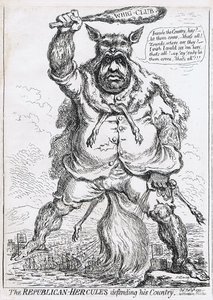The Republican-Hercules Defending his Country.
Only £195.00
Size 25cm x 36cm
Originally published by Hannah Humphrey etched by James Gillray from 'The Genuine Works of James Gillray, engraved by himself. Thomas McLean edition on heavy rag-paper from the original copper plates printed 1830.
Since 1783, James Gillray had been portraying Charles James Fox in an ever-changing variety of guises, establishing a visual equivalence with yet another character in order to define and explain the Whig leader. In various Gillray prints, we have seen Fox portrayed as Milton's jealous Satan, the Biblical traitor Ahitophel, the notorious Guy Fawkes, an attacking bandit, Shakespeare's gluttonous and self-serving Falstaff, a dangerous rattlesnake, a masked executioner, and, most recently, a blood-spattered sans culotte. In all these prints, we are led to understand Fox by thinking of him AS one of these characters—AS Satan, or AS Guy Fawkes.
But Gillray is nothing if not endlessly inventive within the forms of portrait caricature. So here he plays a wonderful variation on his typical procedure. For what we see is not Fox AS Hercules, the mythical strong man whose attributes of club and lion skin would have been well known to Gillray's audience, but (like a wolf in sheep's clothing) Fox PRETENDING TO BE Hercules by donning a skin and using his club.
But unlike the statue of Commodus, where nothing in its presentation disturbs the belief that the Roman emperor Commodus is the demi-god Hercules, in Gillray's depiction of Fox virtually everything cries out "this is NOT Hercules." Gillray shows him as anything but god-like—crude, fat, hairy, swarthy, and unshaven. His clothes are torn and tattered. The skin that covers him, Hercules-like, is NOT a skin from the Nemean lion, but the skin of a fox, serving no special power to protect him but simply reinforcing his identity as the well-known Whig leader. His club is not the fabled weapon of Hercules but the "Whig club" which was derided by the Tory True Briton (13 January 1797) in the following terms.
For what is the Whig Club composed of but the dregs of Party men who have disgraced a political distinction that implied a love of Liberty united with Social Order, while the modern pretenders to that distinction have shewn an attachment to the cause of France degrading to the character of Britons, and have endeavored to defeat the operation of measures calculated to preserve a Constitution which their ancestors were ready to devote their fortunes and their lives.
So while Fox pretends to be a protector of civil liberties, he is shown actively pulling the strings that will bring about a French invasion, saying "Invade the Country, hay?" and then repeating "—let them come. . . ay! ay! only let them come." The gentleman doth protest too much.
In fact, when this print was published in mid-February, the French had already attempted an invasion, not of England but of Ireland with the cooperation of the Irish revolutionaries, Wolfe Tone, Edward Fitzgerald, and Arthur O'Connor. As the British learned shortly after the spectacularly unsuccessful attack in late December of 1796, the plan was to take advantage of discontent in Ireland first to facilitate a revolution there, and then use Ireland as a base from which to attack Britain.
As he so often does in his prints, Gillray portrays the worst-case scenario as already enacted. For the French ships are not attacking from France (East to West) but from Ireland (West to East), an Ireland that has now become, in effect a French colony. And as he later suggests in Evidence to Character: being a Portrait of a Traitor by His Friends and by Himself Gillray seems to believe that Fox was an accessory. (www.james-gillray.org)
 View Account
View Account
